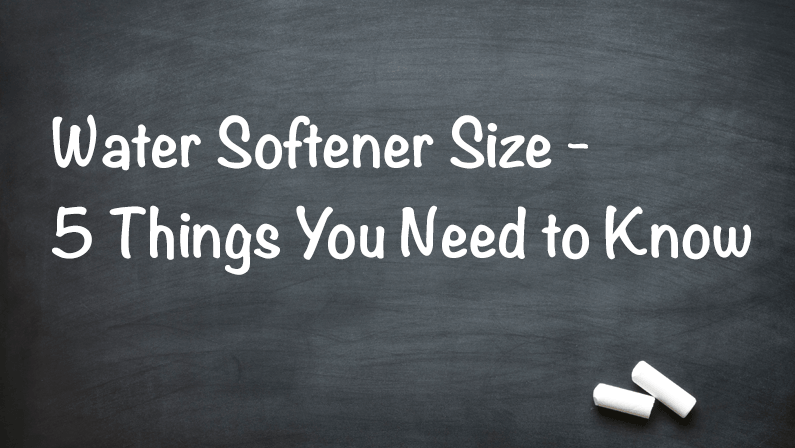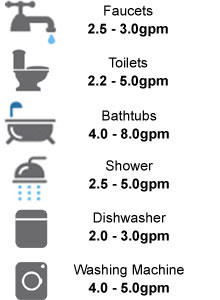Water Softener Size – 5 Factors You Need to Know

So you think you need a water softener for your home, but are not sure where to start.
The first thing you should determine is the actual size of softener you need. A water softener that is too small will frequently run out of soft water, reduce water pressure, require more service, and have a reduced service life. Oddly enough, a water softener that is too big can suffer from a different set of problems.
5 Factors You Need to Know
- Flow Rates
- Water Volume
- Water Quality
- System Capacity
- Regeneration Frequency
Flow Rate Requirements
How many places could your family use water simultaneously? Could you have 2 sinks running, a toilet flush, and bathtub fill at the same time?
Flow rates are measured in gallons per minute (gpm). It’s crucial not to undersize your water softener when it comes to flow rates.
Tip: Add the maximum number of fixtures you could use at once (2 sinks + 1 toilet + 1 bathtub).
If your softener is too small and you try and use too many fixtures simultaneously, you will experience a large drop in water pressure followed by hard water and iron bleed through.
A well engineered system integrates the internal diameter of the bypass valve, control valve, mineral tank, distribution system, as well as the volume and type of ion exchange softening resin. The combination of these components will determine the flow rate a water softener can support.
Water Volume
How much total water does your family use throughout each day – a little, or a lot?
Average domestic water use is 75 gallons per day per person (75gpd/person). This means an average family of 4 would use 300 gallons per day. Heavy water use (lots of laundry, long showers, etc.) can easily add up to 100gpd/person or more.
Tip: Multiply the maximum number of people x your estimated use/person (4×100 = 400gpd)
Water Quality
Water softeners can be used to remove dissolved calcium, magnesium, iron, and manganese.
Calcium and magnesium are measured in grains per gallon (gpg) while iron and magnesium are measured in parts per million (ppm). When sizing a water softener, you must convert the measurement of all minerals into grains per gallon (gpg).
Tip: Multiply parts per million (ppm) of iron and manganese x4 to convert them into grains per gallon
Calculating Total water hardness
20gpg hardness
4gpg iron (1ppm x 4)
1gpg manganese (0.25ppm x 4)
= 25gpg total hardness
Tip: It is far more efficient and effective to use an iron filter to remove iron and manganese instead of a water softener.
System Capacity
Water softeners are full of small plastic beads called ion exchange resin. These resin beads remove hard water minerals by pulling them out of the water – much like a magnet.
A water softener’s capacity is based on the amount of resin inside the unit. 1 cubic foot of resin can remove 32,310 grains of hard water minerals (calcium, magnesium, iron, and manganese).
Tip: Common residential sizes include 0.75, 1.0, 1.5, and 2.0 cubic foot systems
Once a system has reached capacity, the resin beads will be covered with minerals, and be incapable of softening the water. At this point the system will have to clean itself out with salt (also known as regeneration) to resume softening.
Tip 2: To make sure you don’t run out of soft water between regenerations, add 30% extra capacity for a reserve or safety factor.
Regeneration Frequency
Would your car require more service if you drove 40,000 or 10,000 miles per year?
Softeners are no different. Mechanical components in a water softener only have to work during the regeneration process. During service, water simply flows through the system.
Metered water softeners measure the amount of water you use, and will try and regenerate often enough to keep up with usage. An undersized softener will have to regenerate too often, and its mechanical components will work overtime. This excess load reduces the life of all mechanical components.
Tip: The ideal water softener size has enough capacity to las 4 days between regenerations.
Putting it all Together
Here is a common household in the Twin Cities with extremely hard water, lots of water use, and a demanding flow rate requirement:
Flow Requirement
10 gallons per minute (dishwasher + washing machine + 2 sinks)
Volume Requirement
400 gallons per day (4 people x 100gpd/person)
Water Quality
25 grains per gallon (gpg) Total Hardness
The scary part (Math):
400 gallons x 25 grains = 10,000 grains per day
10,000 grains x 4 days = 40,000 grains required
Even scarier (Division!):
40,000 grains/0.7 = 57,412grains capacity required (we just added a 30% reserve)
This family would do best with either a 48,000 grain unit (1.5 cubic feet), or ideally a 64,000 grain unit (2 cubic feet). Anything smaller would run out of capacity and work too hard to keep up. Anything bigger would regenerate too infrequently and may cause resin damage (particularly with iron – but that’s another article altogether).
Our Sample Recommendation
Our 64,000 grain ProMate 6 water softener would be a great match for this family. The 13” diameter tank can deliver up to 18gpm and would not restrict water pressure. It also has enough capacity to operate comfortably and efficiently for a very long time.
With a little thoughtful planning, soft water can be very easy!
Contact us at (952) 479-4553 for a Free Site inspection, Water Use Survey, and Water Test to pick the right softener for you.


Softened water unites with soap limiting bathtub rings, allows better results with clothes washers and dishwashers, and leaves shower doors virtually free of the usual soap scum build-up. Most laundry and dishwashing detergents contain a lot of sodium.
What do you mean in the first paragraph “Oddly enough, a water softener that is too big can suffer from a different set of problems.”
Excessively slow water flow actually “slips” around resin and doesn’t get softened. Thanks for posting!
So what do i do to meet a max flow rate of 85 gpm if everything was been used but normally 4 people in house with 12 gr hard water? 400x 12 =4800 x 5 days = 24000. So a 48000 gr softener would work by capacity but only give me abt 14gpm. At times i have high flow rates. From what ive read a big softener wont work because it will channel and the right size cant meet the flow. I am very confused
You must have 2″ plumbing – correct? I would use 2-3 tanks that are run by a central controller that allows the tanks to come online as the flow rate increases.
Thanks for posting!
Lars
recently had a leak in my peak brass T joint. 2 ppl, one bathroom, one shower and kitchen. I have a water filter but definitely need a water softner. well water. what size??
Are you trying to size a replacement softener? If so, how hard is the water? Thanks!
What does it mean if my display on the water softener is always saying “ current flow rate 0.0 gpm”?
Is the system not working ?
It does a regen every 7 days.
Hey Chris,
0.0gpm means zero gallons per minute (gpm) of water is being used. If you turn on a faucet that your system feeds, it should display a real time flow rate (ie 1.5gpm).
Thanks for posting!